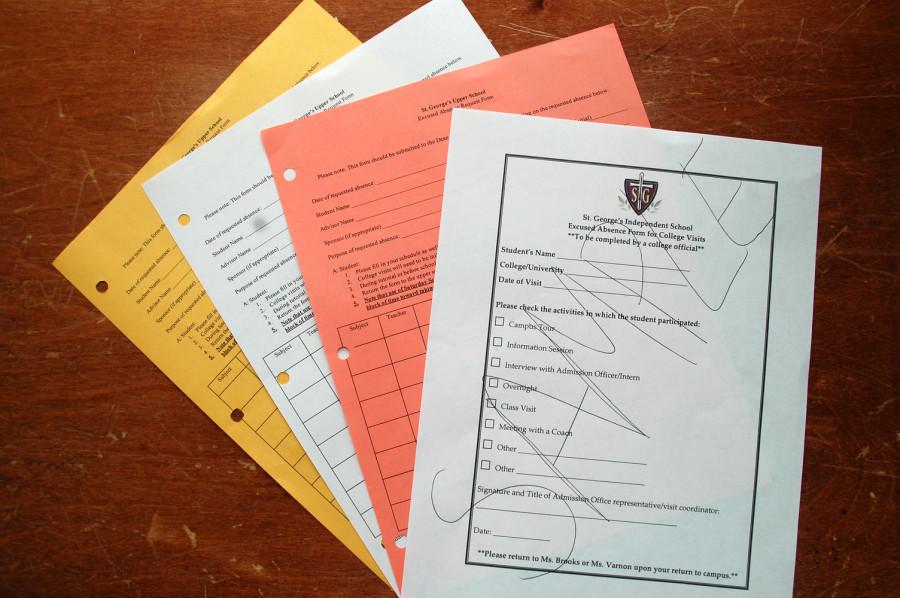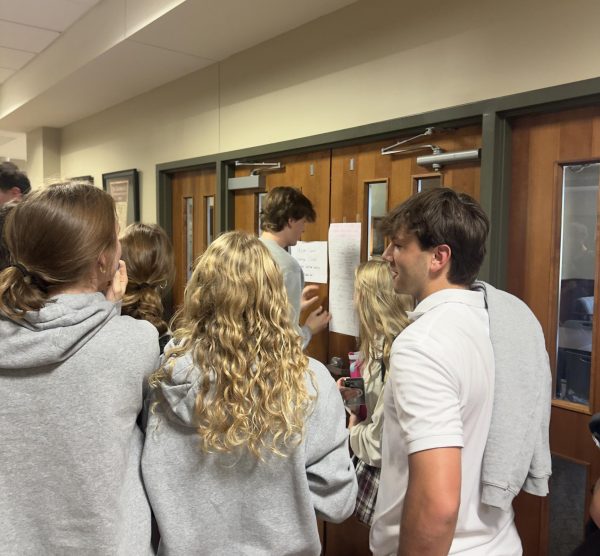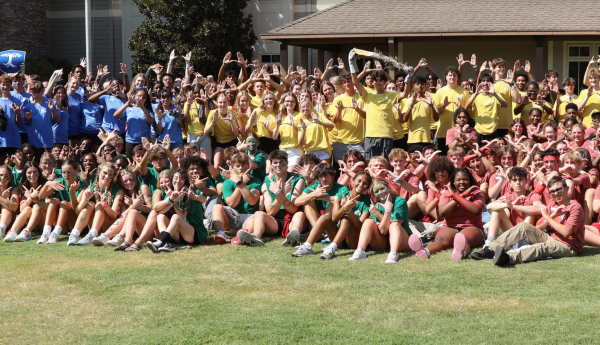Deans try colorful approach to excused absences
Photo: Juliana Wall
The four forms all laid out together. Mrs. Reilly and Mrs. Irvin thought it best to color code the three main forms in order to differentiate the process of excused absences.
In their first year of being in charge of the excused absence process, Mrs. Jill Reilly and Mrs. Kayla Irvin have implemented new steps in order to add accountability for the school and students.
“Teachers plan their classes a week in advance, so having students request absence [forms] a week before they leave actually helps teachers plan schedules,” said Mrs. Reilly.
Before anything else can happen, Mrs. Reilly must receive an email from the student’s parent, in order to document parents’ permission for their student to miss school. Mrs. Irvin then fills out a form with the individual student’s classes.
There are three different colored forms, each color signifying a certain type of excused absence. Pink forms are for general absences, whether that be for family vacations, medical appointments, etc. White forms are for school sponsored absences that are not traditional class field trips such as chorus, anatomy, or Citizenship trips.
Gold forms are assigned to college visits, which have special sections for College Guidance to sign off saying they are aware of what college you are visiting. Students are also asked to get an administrator at the college to sign an additional form in hopes that St. George’s can strengthen relationships with all of the colleges in which students are interested.
A second additional component to these forms is the color pen in which Mrs. Irvin initially fills them out. Blue ink means the student requested their excused absence in time and are able to make up work during the regular time period, which usually means the amount of days missed is equivalent to the days the student has to make up the work.
“If written in red ink, though, the student was late in their request and although they are still technically excused for their absence, they will have to turn in all work they will miss before they leave,” said Mrs. Irvin.
However, teachers do have the latitude to work with specific students if they see it necessary, otherwise, any work not turned in before the student leaves cannot be made up.
Emails are sent to students when their forms are ready to be picked up from the memo box outside of Mrs. Reilly’s office. Once students have teachers fill out the form, they return it to the memo box and they are done.
Although this process seems to help the administration, there has been some confusion and slight frustration in students’ reaction. Part of the confusion is due to the fact that there was no clear announcement of these changes to the students themselves. When they went to get the form, they did not know what to do at first, in addition to the fact that these changes were implemented in the middle of the year.
“Sometimes it can backfire on students because I had something come up last minute where I had to miss school and I had to turn all my work before I left,” said sophomore Kendall LoCascio.
This being said, Mrs. Reilly strives to be able to come up with support plans for students in unique situations. Since the high school has been doing excused absences a certain way for a while, this new direction will take some time to get used to considering not everyone has gone through it yet.
Mrs. Reilly hopes that they can get feedback from students and teachers in order to improve the system to make it easier on all parties.
“It is about getting students to be proactive because it is what they will have to do in college and in real life,” said Mrs. Reilly.
She is working to see if a future online request form for excused absences could work. They would only be accessed through parent’s accounts on Veracross, but it would clean up some of this process. If this does happen, it would not be implemented until next year, but students, teachers, and parents can find some solace in the fact that they are trying to make this process as easy but also as reliable as possible.
“Communication is key,” said Mrs. Reilly. “So far we have had one hundred percent of people bringing forms back, but we are always looking for ways to improve the system.”












